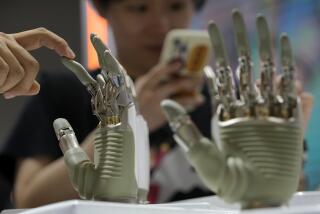Beauty and the Beast
- Share via
What makes a computer elegant? Why did so many users latch onto warty DOS computers while passing over the refined Apple system? Why do so many love computing despite constant frustration? Why do we replace our computers as often as they replaced cars in the 1950s? Why spend three grand on a battery-operated, full-color laptop computer that’s mainly used for solitaire? Maybe it’s the beauty of the machine.
In his charming ramble through the landscape of technology, David Gelernter, a highly respected inventor of computer languages and a professor at Yale, points out the birds, butterflies and toads of computing. He appreciates rhythm, grace and whimsy. “Machine” grins with the exuberance of the Chrysler Building. Reading his text, I feel I’m hiking the technological forest alongside a sharp-witted ornithologist. How I wish this journey lasted longer.
Yes, beauty is in the eye of the user. The elegant program that you created, designed and coded may be simultaneously loved and hated by others. Yet some aspects of computing sing with a resonance that transcends daily life.
Need to sort a shuffled deck of cards? There’s an obvious way--insert the cards one by one into order. It works, but oh, how slowly! Faster for the computer to look at the top card, then split the deck into cards that are smaller and cards that are larger. Repeat this splitting process on each new pile and pretty soon, the deck is sorted. Only a little faster for 52 cards, but it’s way zippier for a stack of 10,000. This algorithm, Quicksort, saves huge amounts of time; it’s powerful, simple and beautiful.
Yet beauty in computing often evolves into the ugly. Few programs maintain their original size, ease of use or elegance. The Unix operating system was born simple, compact and terse but over the decades has evolved into an exquisitely rococo complexity, frustrating programmers, designers and, especially, users. Some purists think the Macintosh has done the same.
Why such pressure to continue adding minor improvements at a cost of elegance and simplicity? And why hasn’t the beautiful won out over the clumsy? In the classic battle between the elegant Macintosh and the clunky IBM/DOS system, why did Apple emerge the loser? Gelernter explores the common excuses--cost, speed, first-to-market, marketing pressures, cloning, advertising--and finds one overlooked reason.
Beautiful technology is unmanly. It shows machismo to master the keyboard commands of DOS; only sissies need a mouse and icons. It’s reminiscent of 1912 cars, when the electric starter motor was promoted as a ladies’ aid. Through the 1980s, Microsoft was famous for selling serious, ugly software. The emergence of Windows, with its mouse and icons, was like President Nixon going to China.
Consider the “graceless, lumpy objects” enshrined on our desktops. Why so boring? Who decided that a million monitors must be pale dove gray? As I grin at Gelernter’s designs for Art Deco computer displays, I wonder: Why can’t I buy a computer as attractive as the joyous tabletop radios of the 1930s? Why do so many people with otherwise good taste happily pay big bucks for such bland ugliness?
Of course, uglification affects more than just computing--videotape recorders, microwave ovens, even home thermostats are afflicted with obnoxious interfaces, annoying assumptions and unsightly cabinets.
Two issues tug at the designer: aesthetic beauty and functional beauty. Every systems designer should repeat Gelernter’s mantra: Technology’s most important obligation is to get out of the way. Machinery should make life easier; useless features and bad design make technology a self-important nuisance instead of a help.
I wish Gelernter would turn his critical eye toward the World Wide Web. For all the glitz and graphics served up by hypertext, we lack an online aesthetic or any sense of what constitutes beauty in a Web page. And despite his experience, he’s optimistic that his own elegant solutions will one day be widely accepted.
Most computer professionals promote technology with glowing predictions of some wonderland just around the corner. Gelernter is one of the rare authorities who wishes to improve things by criticizing what’s wrong within the field he loves. His skepticism, passion and wit refresh a field overgrown with hyperbole.
Complementing this work is Gregory Rawlins’ equally short book, “Slaves of the Machine.” Though it’s aimed more at novices, propeller heads will appreciate his insight and commentary.
Both Gelernter and Rawlins discuss the theoretical development of the computer. In the 1930s, the British mathematician Alan Turing demonstrated the kinds of problems that could be solved with a computer. Gelernter sees scientific beauty in the simplicity of Turing’s work; Rawlins shows Turing’s historic importance.
Rather than admire the aesthetics of old devices, Rawlins sees limitations and pimples. Telephones, elevators and banks simply wouldn’t be possible on today’s scale if we needed human operators and tellers. This recognition of the power of unmanned technology grows into a paean to progress, full of optimism and praise but surprisingly lacking in scepticism. In the future, computers will be “a million times smaller, cheaper and faster.” Since he sets no date, that might just happen. “Best of all,” he continues, “they’ll be a million times easier to use.” Oh, sure.
Has anyone not heard these cliches about the explosion of technology? Rawlins’ gee-whiz prose is straight out of the 1939 World’s Fair: “Because of faster and more extensive communications, more new things with more new functions are invented by more new people for more new tasks, and all are introduced into society more quickly and more cheaply than ever before.”
While Gelernter focuses on aesthetics, Rawlins sees biological metaphors in computing. The computer evolves with time, and he predicts that someday computers will adapt and become “more alien than anything we can ever imagine.” Your future, according to Rawlins, will be wonderful and terrifying.
But hold on: What is more alien in the office today--a word processor or a typewriter? The problem isn’t the fear of technology but rather a blind, uncritical acceptance of it.
Why do computer experts so confidently predict the future when they’re often wrong? Witness the artificial intelligence debacle of the 1980s. Billions were spent to develop a new generation of computers. Nothing came of it. Apparently the ability to write programs and analyze algorithms gives neither social insight nor predictive qualities. If you wish to know what will happen next century, talk with a historian. Better yet, ask a schoolteacher.
Yet Rawlins says that the joy in programming simply can’t be comprehended by non-programmers. I think this explains the pomposity of some systems jocks; since outsiders can’t understand their work, they should be above review.
Still “Slaves of the Machine” gives a real understanding of the joy of programming. Here Rawlins is at his best: showing just why people can’t build arbitrarily huge programs. A complex software project might demand a million lines of code, yet a good programmer might grind out 20 lines of code a day. Worse, adding more people to a software project doesn’t speed things up as we’d wish; perversely, more programmers often slow down delivery.
Solution? Rawlins and other computer scientists look to automated programming. Sure enough, since the 1950s, programmers have tried to create automatic programming systems. And for just as long, complex systems have run over schedule and over budget. Rawlins shows that the problem is not limited to computers: City planners face the same challenges. Indeed, complexity makes programming as tough as politics.
Like Gelernter, Rawlins says little about the Internet and the World Wide Web. Is it because networks have become less of a computer interaction than a social interaction? Or maybe computer scientists prefer to discuss classic problems involving computability and artificial intelligence?
Will tomorrow’s systems, so much more complex, bring forth similar feelings? Will future techies look back with nostalgia at 1998 as the golden age of computing? Will our Pentium processors one day be as collectible as a 1930s blender? Will the struggle between beauty and utility be resolved in computing? These books take me back to elegant programs built by obsessive programmers. Then I remember software projects best compared to creatures from the Jurassic, and I wonder when or if the computer’s Ice Age will come.






